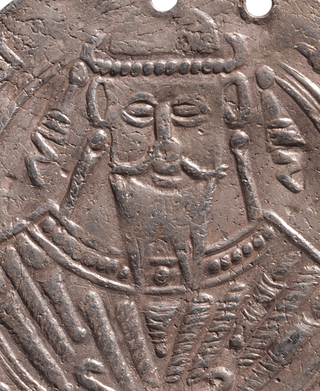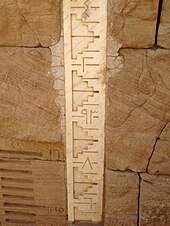
Year 861 (DCCCLXI) was a common year starting on Wednesday of the Julian calendar.
Following the Islamic conquest in 639, Lower Egypt was ruled at first by governors acting in the name of the Rashidun Caliphs and then the Umayyad Caliphs in Damascus, but in 747 the Umayyads were overthrown. Throughout Islamic rule, Askar was named the capital and housed the ruling administration. The conquest led to two separate provinces all under one ruler: Upper and Lower Egypt. These two very distinct regions were governed by the military and followed the demands handed down by the governor of Egypt and imposed by the heads of their communities.

Ja'far ibn Muhammad ibn Harun ; March 822 – 11 December 861, commonly known by his regnal name al-Mutawwakil ala Allah, was the tenth Abbasid caliph, ruling from 847 until his assassination in 861. He succeeded his brother, al-Wathiq, and is known for expanding the empire to its maximum extent. He was deeply religious, and is remembered for discarding the Muʿtazila, ending the Mihna, and releasing Ahmad ibn Hanbal. He is also known for his tough rule, especially with respect to non-Muslim subjects.

Abū al-ʿAbbās Aḥmad ibn Muḥammad ibn Kathīr al-Farghānī also known as Alfraganus in the West, was an astronomer in the Abbasid court in Baghdad, and one of the most famous astronomers in the 9th century. Al-Farghani composed several works on astronomy and astronomical equipment that were widely distributed in Arabic and Latin and were influential to many scientists. His best known work, Kitāb fī Jawāmiʿ ʿIlm al-Nujūmi, was an extensive summary of Ptolemy's Almagest containing revised and more accurate experimental data. Christopher Columbus used Al Farghani’s calculations for his voyages to America. In addition to making substantial contributions to astronomy, al-Farghani also worked as an engineer, supervising construction projects on rivers in Cairo, Egypt. The lunar crater Alfraganus is named after him.

Abū ʿAbd Allāh Muḥammad ibn Jaʿfar, better known by his regnal title al-Muʿtazz bi-ʾllāh was the Abbasid caliph from 866 to 869, during a period of extreme internal instability within the Abbasid Caliphate, known as the "Anarchy at Samarra".

Abu’l-ʿAbbās Aḥmad ibn Jaʿfar, better known by his regnal name al-Muʿtamid ʿalā ’llāh, was the caliph of the Abbasid Caliphate from 870 to 892. His reign marks the end of the "Anarchy at Samarra" and the start of the Abbasid restoration, but he was largely a ruler in name only. Power was held by his brother al-Muwaffaq, who held the loyalty of the military. Al-Mu'tamid's authority was circumscribed further after a failed attempt to flee to the domains controlled by Ahmad ibn Tulun in late 882, and he was placed under house arrest by his brother. In 891, when al-Muwaffaq died, loyalists attempted to restore power to the Caliph, but were quickly overcome by al-Muwaffaq's son al-Mu'tadid, who assumed his father's powers. When al-Mu'tamid died in 892, al-Mu'tadid succeeded him as caliph.

The Mosque of Ibn Tulun is located in Cairo, Egypt. It is one of the oldest mosques in Egypt as well as the whole of Africa surviving in its full original form, and is the largest mosque in Cairo in terms of land area. It is built around an open square courtyard which allows natural light to travel through. Ibn Tulun Mosque features ancient architecture styles of Egypt, its decorations being created from carved stucco and wood. This mosque is a popular tourist attraction.
Abū Bakr Muḥammad ibn Ṭughj ibn Juff ibn Yiltakīn ibn Fūrān ibn Fūrī ibn Khāqān, better known by the title al-Ikhshīd after 939, was an Abbasid commander and governor who became the autonomous ruler of Egypt and parts of Syria (Levant) from 935 until his death in 946. He was the founder of the Ikhshidid dynasty, which ruled the region until the Fatimid conquest of 969.

The History of the Prophets and Kings, more commonly known as Tarikh al-Tabari or Tarikh-i Tabari or The History of al-Tabari is an Arabic-language historical chronicle completed by the Muslim historian Muhammad ibn Jarir al-Tabari in 915 AD. It begins with creation, and charts Muslim and Middle Eastern history from the myths and legends associated with the Old Testament through to the history of the Abbasid era, down to the year 915. An appendix or continuation, was written by Abu Abdullah b. Ahmad b. Ja'far al-Farghani, a student of al-Tabari.

The Tulunids, were a Mamluk dynasty of Turkic origin who were the first independent dynasty to rule Egypt, as well as much of Syria, since the Ptolemaic dynasty. They were independent from 868, when they broke away from the central authority of the Abbasid Caliphate, to 905, when the Abbasids restored the Tulunid domains to their control.
Ahmad ibn Tulun was the founder of the Tulunid dynasty that ruled Egypt and Syria between 868 and 905. Originally a Turkic slave-soldier, in 868 Ibn Tulun was sent to Egypt as governor by the Abbasid caliph. Within four years Ibn Tulun had established himself as a virtually independent ruler by evicting the caliphal fiscal agent, Ibn al-Mudabbir, taking over control of Egypt's finances, and establishing a large military force personally loyal to himself. This process was facilitated by the volatile political situation in the Abbasid court and the preoccupation of the Abbasid regent, al-Muwaffaq, with the wars against the Saffarids and the Zanj Rebellion. Ibn Tulun also took care to establish an efficient administration in Egypt. After reforms to the tax system, repairs to the irrigation system, and other measures, the annual tax yield grew markedly. As a symbol of his new regime, he built a new capital, al-Qata'i, north of the old capital Fustat.
The Battle of Dayr al-Aqul was fought on 8 April 876, between forces of the Saffarid ruler Ya'qub ibn Laith and the Abbasid Caliphate. Taking place some 80 km southeast (downstream) of Baghdad, the battle ended in a decisive victory for the Abbasids, forcing Ya'qub to halt his advance into Iraq.

Roda Island is an island neighbourhood in the Nile in central Cairo, alternatively or partially known as Manial al-Roda, or al-Manial, in reference to the main village that existed on the island before it was urbanised, and is part of the Misr al-Qadima district.
Abu Ahmad Talha ibn Ja'far, better known by his laqab as Al-Muwaffaq Billah, was an Abbasid prince and military leader, who acted as the de facto regent of the Abbasid Caliphate for most of the reign of his brother, Caliph al-Mu'tamid. His stabilization of the internal political scene after the decade-long "Anarchy at Samarra", his successful defence of Iraq against the Saffarids and the suppression of the Zanj Rebellion restored a measure of the Caliphate's former power and began a period of recovery, which culminated in the reign of al-Muwaffaq's own son, the Caliph al-Mu'tadid.
Ṭughj ibn Juff ibn Yiltakīn ibn Fūrān ibn Fūrī ibn Khāqān was a Turkic military officer who served the Abbasid Caliphate and the autonomous Tulunids. He was the father of Muhammad al-Ikhshid, the founder of the Ikhshidid dynasty.
Muhammad ibn Sulayman, surnamed al-Katib, was a senior official and commander of the Abbasid Caliphate, most notable for his victories against the Qarmatians and for his reconquest of Syria and Egypt from the autonomous Tulunid dynasty.
Isa ibn Muhammad al-Nushari or Isa ibn Musa al-Nushari was an Abbasid commander and governor of Isfahan in 896–900 and of Egypt from 905 to his death in spring 910.
Badr ibn ʿAbdallāh al-Ḥammāmī also known as Badr al-Kabīr, was a general who served the Tulunids and later the Abbasids.
Abu Abdallah Ja'far ibn Abd al-Wahid ibn Ja'far ibn Sulayman ibn Ali al-Hashimi was a Chief judge of the Abbasid Caliphate, from 854 to 863/4.














